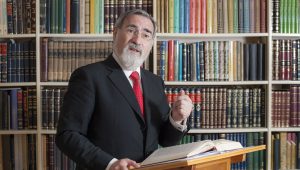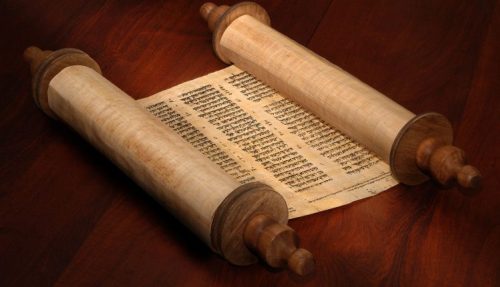On Judaism and Islam
Chayei Sarah 5779
The language of the Torah is, in Erich Auerbach’s famous phrase, “fraught with background.” Behind the events that are openly told are shadowy stories left for us to decipher. Hidden beneath the surface of Parshat Chayei Sarah, for example, is another story, alluded to only in a series of hints. There are three clues in the text.
The first occurs when Abraham’s servant is returning with the woman who is to become Isaac’s wife. As Rebecca sees Isaac in the distance, we are told that he is “coming from the way of Be’er-la?ai-ro’i” (Gen. 24:62) to meditate in the field. The placement is surprising. Thus far we have situated the patriarchal family at Be’ersheva, to which Abraham returns after the binding of Isaac, and Hebron, where Sarah dies and is buried. What is this third location, Be’er-la?ai-ro’i, and what is its significance?
The second is the extraordinary final stage of Abraham’s life. In chapter after chapter we read of the love and faithfulness Abraham and Sarah had for one another. Together they embarked on a long journey to an unknown destination. Together, they stood against the idolatry of their time. Twice, Sarah saved Abraham’s life by pretending to be his sister. They hoped and prayed for a child and endured the long years of childlessness until Isaac was born. Then Sarah’s life draws to a close. She dies. Abraham mourns and weeps for her and buys a cave in which she is buried, and he is to be buried beside her. We then expect to read that Abraham lived out the rest of his years alone before being placed beside “Sarah his wife” in the Cave of Machhpelah (Gen. 25:9).
Unexpectedly, however, once Isaac is married, Abraham marries a woman named Keturah and has six children by her. We are told nothing else about this woman, and the significance of the episode is unclear. The Torah does not include mere incidental details. We have no idea, for example, what Abraham looked like. We do not even know the name of the servant he sent to find a wife for Isaac. Tradition tells us that it was Eliezer, but the Torah itself does not. What then is the significance of Abraham’s second marriage and how is it related to the rest of the narrative?
The third clue to the hidden story is revealed in the Torah’s description of Abraham’s death:
And Abraham expired, and died in a good old age, an old man, and full of years, and was gathered to his people. Isaac and Ishmael, his sons, buried him in the Cave of Machpelah, in the field of Ephron the son of Zohar the Hittite, which is before Mamre, the field which Abraham purchased of the children of Het. There was Abraham buried, and Sarah his wife. (Gen. 25:8–10)
Ishmael’s presence at the funeral is surprising. After all, he had been sent away into the desert years before, when Isaac was young. Until now, we have assumed that the two half-brothers have lived in total isolation from one another. Yet the Torah places them together at the funeral without a word of explanation.
The sages piece together these three puzzling details to form an enthralling story.
First, they point out that Be’er-la?ai-ro’i, the place from which Isaac was coming when Rebecca saw him, is mentioned once before in Genesis (16:14): It is the spot where Hagar, pregnant and fleeing from Sarah, encountered an angel who told her to return. It is indeed she who gives the place its name, meaning “the well of the Living One who sees me” (Gen. 16:14). The Midrash thus says that Isaac went to Be’er-la?ai-ro’i in search of Hagar. When Isaac heard that his father was seeking a wife for him, he said, “Shall I be married while my father lives alone? I will go and return Hagar to him.”¹
Hence the sages’ answer to the second question: who was Keturah? She was, they said, none other than Hagar herself. It is not unusual for people in the Torah to have more than one name: Jethro, Moses’s father-in-law, had seven. Hagar was called Keturah because “her acts gave forth fragrance like incense (ketoret).”² This indeed integrates Abraham’s second marriage as an essential component of the narrative.
Hagar did not end her days as an outcast. She returned, at Isaac’s prompting and with Abraham’s consent, to become the wife of her former master. This also changes the painful story of the banishment of Ishmael.
We know that Abraham did not want to send him away – Sarah’s demand was “very grievous in Abraham’s sight on account of his son” (Gen. 21:11). Nonetheless, God told Abraham to listen to his wife. There is, however, an extraordinary Midrash, in Pirkei deRabbi Eliezer, which tells of how Abraham twice visited his son. On the first occasion, Ishmael was not at home. His wife, not knowing Abraham’s identity, refused the stranger bread and water. Ishmael, continues the Midrash, divorced her and married a woman named Fatimah. This time, when Abraham visited, again not disclosing his identity, the woman gave him food and drink. The Midrash then says “Abraham stood and prayed before the Holy One, blessed be He, and Ishmael’s house became filled with all good things. When Ishmael returned, his wife told him about it, and Ishmael knew that his father still loved him.”³ Father and son were reconciled.
The name of Ishmael’s second wife, Fatimah, is highly significant. In the Koran, Fatimah is the daughter of Mohammad. Pirkei deRabbi Eliezer is an eighth-century work, and it is here making an explicit, and positive, reference to Islam.
The hidden story of Chayei Sarah has immense consequence for our time. Jews and Muslims both trace their descent from Abraham – Jews through Isaac, Muslims through Ishmael. The fact that both sons stood together at their father’s funeral tells us that they too were reunited.
Beneath the surface of the narrative in Chayei Sarah, the sages read the clues and pieced together a moving story of reconciliation between Abraham and Hagar on the one hand, Isaac and Ishmael on the other. Yes, there was conflict and separation; but that was the beginning, not the end. Between Judaism and Islam there can be friendship and mutual respect. Abraham loved both his sons, and was laid to rest by both. There is hope for the future in this story of the past.
Shabbat Shalom
[1] Bereishit Rabbah 60:14.
[2] Bereishit Rabbah 51:4.
[3] Pirkei deRabbi Eliezer 30.

An international religious leader, philosopher, award-winning author and respected moral voice, Rabbi Lord Jonathan Sacks was awarded the 2016 Templeton Prize in recognition of his “exceptional contributions to affirming life’s spiritual dimension.” Described by H.R.H. The Prince of Wales as “a light unto this nation” and by former British Prime Minister Tony Blair as “an intellectual giant”, Rabbi Sacks is a frequent and sought-after contributor to radio, television and the press both in Britain and around the world.
Since stepping down as the Chief Rabbi of the United Hebrew Congregations of the Commonwealth – a position he served for 22 years between 1991 and 2013 – Rabbi Sacks has held a number of professorships at several academic institutions including Yeshiva University and King’s College London. In addition to his writing and lecturing, he currently serves as the Ingeborg and Ira Rennert Global Distinguished Professor at New York University. Rabbi Sacks has been awarded 17 honorary doctorates including a Doctor of Divinity conferred to mark his first ten years in office as Chief Rabbi, by the then Archbishop of Canterbury, Lord Carey.
Rabbi Sacks is the author of over 30 books. Among them, Rabbi Sacks has published a new English translation and commentary for the Koren Sacks Siddur, the first new Orthodox siddur in a generation, as well as powerful commentaries for the Rosh HaShana, Yom Kippur, Pesach, Shavuot and Sukkot Machzorim. His most recent work, Not in God’s Name: Confronting Religious Violence was awarded a 2015 National Jewish Book Award in America and was a top ten Sunday Times bestseller in the UK. Past works include: The Great Partnership: God, Science and the Search for Meaning; The Dignity of Difference: How to Avoid the Clash of Civilizations, winner of the Grawemeyer Prize for Religion in 2004 for its success in defining a framework for interfaith dialogue between people of all faith and of none; To Heal a Fractured World: The Ethics of Responsibility; and A Letter in the Scroll: On Being Jewish, winner of a National Jewish Book Awards in 2000. His Covenant & Conversationcommentaries on the weekly Torah portion are read in Jewish communities around the world.
In recognition of his work, Rabbi Sacks has received, among others, the Jerusalem Prize in 1995 for his contribution to diaspora Jewish life, The Ladislaus Laszt Ecumenical and Social Concern Award from Ben Gurion University in Israel in 2011, The Guardian of Zion Award from the Ingeborg Rennert Center for Jerusalem Studies at Bar-Ilan University in 2014, and The Katz Award in recognition of his contribution to the practical analysis and application of Halakha in modern life in Israel in 2014. He was named as The Becket Fund’s 2014 Canterbury Medalist for his role in the defence of religious liberty in the public square; won a Bradley Prize in 2016 in recognition of being “a leading moral voice in today’s world”; and in 2017, he was awarded the Irving Kristol Award from the American Enterprise Institute for his “remarkable contributions to philosophy, religion, and interfaith discourse… as one of the world’s greatest living public intellectuals.” In 2018, he was given the Lifetime Achievement Award by The London Jewish News in recognition of his services to the Jewish world and wider society.
Rabbi Sacks was knighted by Her Majesty The Queen in 2005 and made a Life Peer, taking his seat in the House of Lords in October 2009. Born in 1948 in London, he has been married to Elaine since 1970. They have three children and several grandchildren.






